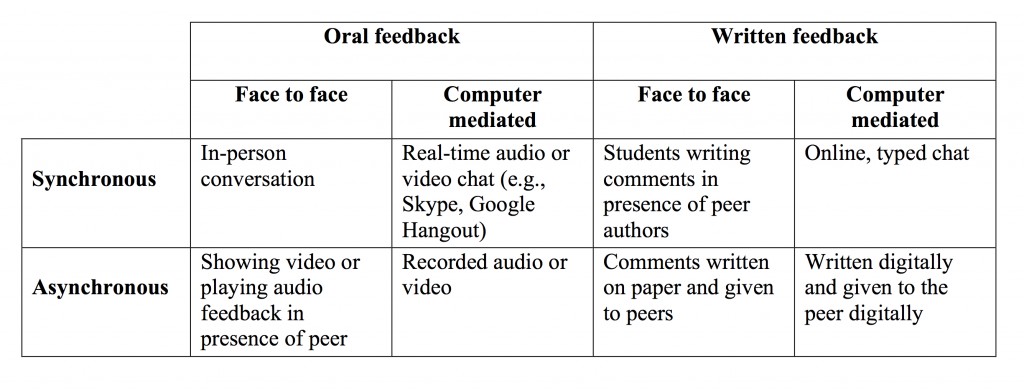In an earlier post I summarized a few studies of peer assessment/peer feedback, and since then I’ve done some more research and found several more studies. What I also realized is that “oral vs written peer feedback” is not an adequate description of the myriad options. There is also synchronous vs. asynchronous, and face-to-face vs. mediated (often computer mediated).
So, written feedback can be asynchronous or synchronous (such as with online “chats”), and done on paper or computer mediated (typed digitally and emailed or uploaded into some online system that allows students to retrieve the comments on their papers).
Oral feedback, in turn, can be face-to-face or computer mediated, and the latter can be asynchronous (such as recorded audio or video) or synchronous (such as real-time video or audio chatting).
Thus, the possibilities are (at least insofar as I understand them at this point):
The situations in two of the boxes are quite rare:
- Oral, asynchronous, face-to-face feedback situation are probably unlikely to happen very often, such as showing videos of one’s feedback to another person in person (or doing the same with an audio recording).
- Written, face-to-face, synchronous feedback by itself is likely also rare, since it’s more probable that students will be writing comments on each others’ papers in each others’ presence while also discussing comments together–in which case the situation would be a blend of written, face-to-face, synchronous and oral, face-to-face, synchronous.
Also, I’m not really sure about the written, face-to-face, asynchronous box; that is only face-to-face insofar as the comments are given to the peer face-to-face, on paper.
The reason why I’m taking the time to distinguish these various permutations is that the literature I’ve been reading lately falls into various boxes on the table. For example, Reynolds and Russell (2008) (see this post) would fall into the oral, computer-mediated, asynchronous box. Most of the literature that talks about “oral” feedback is talking about oral, face-to-face, synchronous feedback (as I was using the term “oral” before now).
So now I guess I’ll need to come up with a new naming convention, and it will likely be an ugly set of abbreviations, such as:
Oral, face-to-face (assumed synchronous): OFTF
— though maybe written face-to-face is rare enough that this could just be FTF?
Oral, computer mediated, synchronous: OCMS
Oral, computer mediated, asynchronous: OCMA
Etc. Quite ugly.
In the next few days I’ll summarize and comment on a few more articles that fall into these various boxes, and then see if I can come up with any conclusions about the different types of oral vs. written peer feedback from those summaries and the ones in the post linked at the beginning, above. Does the research allow for any stable conclusions at this point? I’ll have to see after I think through the various papers I’m about to summarize in the next few days…
Works cited
Reynolds, J. & Russell, R. (2008) Can You Hear Us Now?: A comparison of peer review quality when students give audio versus written feedback, The WAC Journal 19(1), 29-44. http://wac.colostate.edu/journal/vol19/index.cfm

